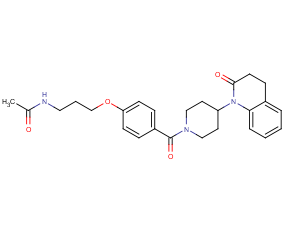
OPC 21268
CAS No. 131631-89-5
OPC 21268( OPC-21268 | OPC21268 | OPC 21268 )
Catalog No. M17244 CAS No. 131631-89-5
OPC 21268 is a non-peptide Arginine vasopressin(AVP) Receptor V antagonist.
Purity : >98% (HPLC)
 COA
COA
 Datasheet
Datasheet
 HNMR
HNMR
 HPLC
HPLC
 MSDS
MSDS
 Handing Instructions
Handing Instructions
| Size | Price / USD | Stock | Quantity |
| 2MG | 47 | In Stock |


|
| 5MG | 72 | In Stock |


|
| 10MG | 97 | In Stock |


|
| 25MG | 164 | In Stock |


|
| 50MG | 230 | In Stock |


|
| 100MG | 398 | In Stock |


|
| 200MG | Get Quote | In Stock |


|
| 500MG | Get Quote | In Stock |


|
| 1G | Get Quote | In Stock |


|
Biological Information
-
Product NameOPC 21268
-
NoteResearch use only, not for human use.
-
Brief DescriptionOPC 21268 is a non-peptide Arginine vasopressin(AVP) Receptor V antagonist.
-
DescriptionOPC-21268 is a vasopressin 1 receptor antagonist potentially for the treatment of heart failure and hypertension.(In Vitro):The concentration of Fuscoside (OPC-21268) that displaces 50% of specific AVP binding (IC50) is 0.4 μM for VI receptors and 100 μM for V2 receptors. The inhibition constant (Ki) of Fuscoside (OPC-21268) for V1 receptors (0.14 μM).(In Vivo):Fuscoside (OPC-21268) competitively and specifically antagonizes pressor responses to AVP in vivo. Oral administration of Fuscoside (OPC-21268) (10 mg/kg) inhibits the vasoconstriction induced by exogenous AVP in a dose- and time-dependent manner and the effect lasts for more than 8 hours at 30 mg/kg. Fuscoside (OPC-21268) predominantly exerts a protective effect in areas where the maximum amount of blood-brain barrier breakdown occurs, and it is effective in the treatment of cold-induced vasogenic brain edema. Fuscoside (OPC-21268) treatment at the dosages of 200 and 300 mg/kg significantly reduces brain water content in both hemispheres. Swelling of the traumatized hemispheres is also significantly reduced at 200 and 300 mg/kg dosages.
-
In VitroThe concentration of Fuscoside (OPC-21268) that displaces 50% of specific AVP binding (IC50) is 0.4 μM for VI receptors and 100 μM for V2 receptors. The inhibition constant (Ki) of Fuscoside (OPC-21268) for V1 receptors (0.14 μM).
-
In VivoFuscoside (OPC-21268) competitively and specifically antagonizes pressor responses to AVP in vivo. Oral administration of Fuscoside (OPC-21268) (10 mg/kg) inhibits the vasoconstriction induced by exogenous AVP in a dose- and time-dependent manner and the effect lasts for more than 8 hours at 30 mg/kg. Fuscoside (OPC-21268) predominantly exerts a protective effect in areas where the maximum amount of blood-brain barrier breakdown occurs, and it is effective in the treatment of cold-induced vasogenic brain edema. Fuscoside (OPC-21268) treatment at the dosages of 200 and 300 mg/kg significantly reduces brain water content in both hemispheres. Swelling of the traumatized hemispheres is also significantly reduced at 200 and 300 mg/kg dosages.
-
SynonymsOPC-21268 | OPC21268 | OPC 21268
-
PathwayCell Cycle/DNA Damage
-
TargetDNA/RNA Synthesis
-
RecptorVasopressin receptor 1
-
Research AreaCardiovascular Disease
-
Indication——
Chemical Information
-
CAS Number131631-89-5
-
Formula Weight449.55
-
Molecular FormulaC26H31N3O4
-
Purity>98% (HPLC)
-
SolubilityDMSO : 50 mg/mL. 111.22 mM;
-
SMILESCC(=O)NCCCOC1=CC=C(C=C1)C(=O)N2CCC(CC2)N3C(=O)CCC4=CC=CC=C43
-
Chemical NameN-(3-(4-(4-(2-oxo-3,4-dihydroquinolin-1(2H)-yl)piperidine-1-carbonyl)phenoxy)propyl)acetamide
Shipping & Storage Information
-
Storage(-20℃)
-
ShippingWith Ice Pack
-
Stability≥ 2 years
Reference
1.Yamamura Y,etal.PC-21268, an orally effective, nonpeptide vasopressin V1 receptor antagonist.Science. 1991 Apr 26;252(5005):572-4.
molnova catalog



related products
-
Floxuridine
Floxuridine (5-fluorodeoxyuridine) is an oncology drug that belongs to the class known as antimetabolites with an GI50 of 5.1 μM for the inhibition of PEPT1.
-
L82
L82 is a DNA ligase 1 (DNA Lig1) inhibitor (hLig1 IC50=12 μM) that is selective and non-competitive.L82 expresses anti-proliferative activity against breast cancer cells.
-
Apricitabine
Apricitabine (SPD754) is a highly selective and orally active HIV-1 reverse transcriptase inhibitor (Ki=0.08 μM), the (-) enantiomer of 2′-deoxy-3′-oxy-4′-thiocytidine (dOTC) .



 Cart
Cart
 sales@molnova.com
sales@molnova.com


